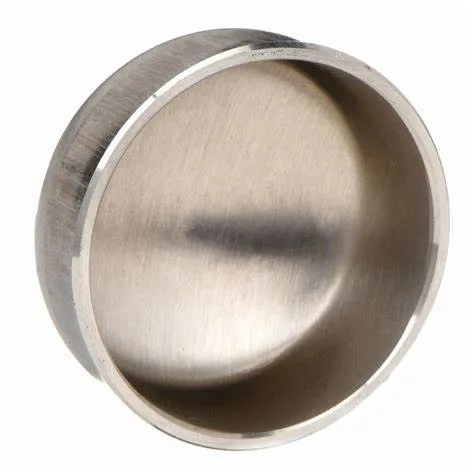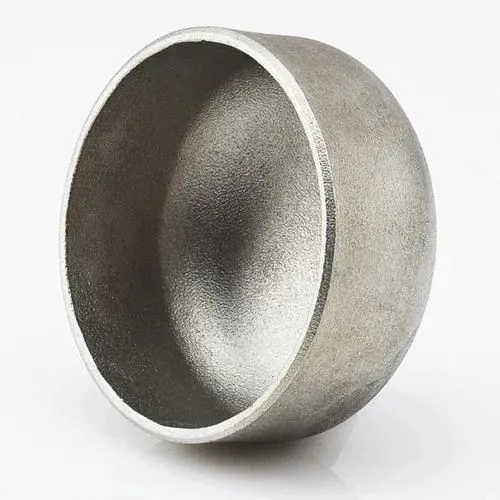O le JIS B2311 o le Japanese Industrial Standard lea e ufiufi ai paipa paipa, e aofia ai pulou o loʻo faʻaaogaina i paipa. O pulou uelo fa'amau e fa'amoemoe e tapuni le pito o se paipa, ma tu'u ai se fa'amaufa'ailoga e puipuia ai le liki po'o le fa'aleagaina. Ole fa'atomuaga lea ile JIS B2311 fa'aulu fa'amau:
- 1. JIS B2311 Standard:
- - JIS B2311 faʻataʻitaʻiga o loʻo faʻamaonia ai manaʻoga mo le mamanu, fua, meafaitino, gaosiga, ma suʻega o mea faʻapipiʻi faʻapipiʻi, e aofia ai pulou, i totonu o paipa.
- - E fa'amautinoaina e le fa'atonuga o pulou na gaosia e tusa ai ma fa'amaumauga a le JIS e fetaui ma tulaga lelei ma e fetaui ma isi vaega paipa.
- 2. U'u-uo-uo pulou:
- - O se pulou faʻapipiʻi, e tusa ai ma le JIS B2311, o se mea faʻapipiʻi ua mamanuina e ufiufi ma faʻamaufaʻailogaina le pito o se paipa ma le saogalemu, ofoina atu le puipuiga ma le faʻamautuina o le amio saʻo o le paipa.
- - O pulou e faʻaaogaina i tulaga e manaʻomia ai le tapuni o le pito paipa, pe tumau pe le tumau, e puipuia ai le tafe, faʻaleagaina, poʻo le faʻamaeʻaina o le masini.
- 3. Mea ma Fausia:
- - Butt-ulding caps i lalo o le JIS B2311 specifications o loʻo maua i mea eseese e pei o le carbon steel, stainless steel, ma le uʻamea uʻamea e faʻafetaui ai manaʻoga eseese.
- - O nei pulou o loʻo gaosia e faʻaaoga ai metotia faʻatulagaina faʻavae e faʻamautinoa ai se fesoʻotaʻiga malosi ma leai se liki pe a faʻapipiʻi i le pito o se paipa.
- 4. Talosaga ma Faamanuiaga:
- - O pulou faʻapipiʻi e maua ai faʻaoga i pisinisi eseese, e aofia ai le suauʻu ma le kesi, vailaʻau vailaʻau, vai vai, ma isi mea e manaʻomia ai le faʻamauina o pito paipa.
- - O pulou e maua ai le puipuiga i pito paipa mai elemene siosiomaga, puipuia le faaleagaina, ma fesoasoani e faatumauina le mama ma le saʻo o le paipa.
- 5. Fa'apipi'i ma Uila:
- - O faiga fa'apipi'i sa'o, e aofia ai le fa'aoga sa'o, tapenaga o le pito o paipa, ma auala u'i, e mana'omia pe a fa'apipi'i pulou fa'amau e fa'amautu ai se fa'amaufa'ailoga mautu ma le liki.
- - O le uelo o se auala masani mo le faʻapipiʻiina o pulou i paipa, tuʻuina atu se tapunia mautu ma tumau e mafai ona tatalia le mamafa, fesuiaiga o le vevela, ma le tafe o le vai i totonu o le masini.
- I se aotelega, JIS B2311 butt-weld caps o vaega taua ia e faʻaogaina i paipa e faʻamau ma puipuia le pito o paipa ma le saogalemu. O nei pulou e ogatasi ma tulaga faʻapitoa e faʻamautinoa ai le lelei, faʻamaoni, ma le fetaui i totonu o fale gaosi oloa e manaʻomia ai le tapuni ma le puipuiga o paipa.
What Is a Butt Welding Cap and How Is It Used in Industrial Piping?
In industrial piping systems, end-of-line sealing and branch closures require robust solutions. A butt welding cap serves as a critical component for terminating pipes securely. By providing a seamless, welded closure, this fitting maintains system integrity, prevents leaks, and supports compliance with industry standards.
What Is a Butt Welding Cap?
A butt welding cap—also called a pipe end cap or buttweld end cap—is a round fitting designed to close off the end of a pipe. It’s manufactured to match the pipe’s outer diameter and schedule, with either a hemispherical or flat face. To install, both the pipe end and cap are beveled to form a V‑groove, enabling full‑penetration, fusion welds. Common materials include carbon steel, stainless steel, nickel alloys, and other engineered grades, chosen to satisfy pressure, temperature, and corrosion‑resistance requirements.
How Is Butt Welding Cap Used in Industrial Piping?
Butt welding caps find application across oil & gas, petrochemical, power generation, water treatment, and general process industries for both permanent and temporary closures. During hydrostatic testing, technicians install caps to seal off sections of piping while monitoring for leaks. In new construction or retrofit projects, caps terminate branch lines, future tie‑in spools, or dead‑end mains until system expansion. Welders prepare each joint by cleaning and beveling surfaces, aligning the cap precisely, and executing a root pass followed by filler passes per the qualified Welding Procedure Specification (WPS). Post‑weld heat treatment and non‑destructive examination (NDE)—such as radiography or ultrasonic testing—verify weld integrity and compliance with ASME B16.9 and related standards. Additionally, temporary caps enable safe isolation during maintenance, allowing for segment testing and dewatering under regulatory protocols.
Benefits and Best Practices
Butt welding caps offer a smooth‑bore transition that minimizes flow disruption and stress concentration. Their full‑penetration welds deliver exceptional structural strength and leak resistance. To optimize performance, engineers should:
Select caps with matching material grades and wall thicknesses
Adhere to proper bevel angles and joint fit‑up tolerances
Follow qualified WPS protocols rigorously
Consider cladding or protective coatings in corrosive environments to extend service life
Regular inspection and thorough documentation ensure long‑term reliability and safe operation under demanding conditions.
Butt welding caps are indispensable components for achieving durable, leak‑proof pipe terminations in a wide range of industrial applications.
Butt Welding Cap FAQs
What is a butt welding cap?
|
O a mea e masani ona fa'aaogaina?
|
What standards govern butt welding caps?
|
How are butt welding caps installed?
|
Where are butt welding caps typically used?
|
What are the advantages of threaded caps?
|
















